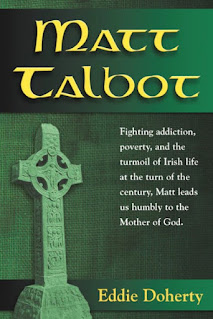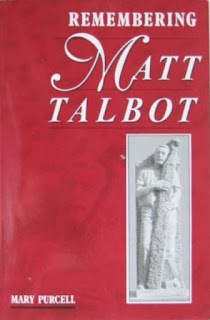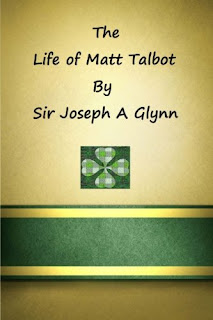The Holy Man of Dublin or the Silence of Matt Talbot
Eily MacAdam
The Anthonian Press
Dublin (1938)
24p
It has taken me a while to track down an actual copy of this volume. I had found online a couple different version of Matt Talbot by Eily MacAdam. This one is a few years after but has the exact cover as The Holy Man of Dublin: or the Silence of Matt Talbot by Alice Curtayne even though the subtitle is different and they were published three years apart. The subtitle and author only appears on the title page not even on the cover of the booklet. And it leaves me wondering if there are other booklets about him by the same title but by other authors.
This was the six volume I have read about Matt Talbot and also the piece about Matt in the volume The Irish Way: Studies in Irish Sanctity from St. Patrick to Matt Talbot, edited by F.J. Sheed. I have tracked down and read a number of biographies about Matt now and still have one I have yet to read and one I have not been able to track down.
The text of this original edition does not have the first three paragraphs of the online version, nor does it have a timeline, and prayer at the end. This is a very brief biography. It contains 6 illustrations; there are 24 pages of text. The illustrations and photos are the same ones that appear in the Curtayne volume but in a different order in this later work. I highlighted numerous passages my first time through this volume. Some of them are:
“One night he was not sober when he came home to that good mother and the upright father. He was caned, removed from the job and a position found for him in the bonded stores of which his father had charge. It was soon evident that Matt was going to be a heartbreak. He began to drink whiskey and his poor father had the terrible knowledge that somehow that whiskey was coming out of the stores of which he was in charge. More canings followed. Matt got himself a new job, after four years in which his father had tried every means to keep him straight. Matt became a bricklayer’s labourer. He was now seventeen and for several years he worked for different building contractors, and ultimately got a permanent job with Messrs. T. & C. Martin at the North Wall where for the rest of his life he worked loading carts, unloading timber, etc., until ultimately he became storekeeper.”
“He went home that day. His mother greeted him with a remark about his early return. “And you’re sober,” she added. He said nothing but when he had eaten his dinner he dressed himself. He was going to take the pledge, he said. We know nothing of what was working in his soul that day. With a gentle smile his mother bade him be sure he meant to keep itbefore he took it.”
“If we let ourselves forget that Matt Talbot was young when he entered on his fight we miss the thrill of it. Old men pray more easily. The body is less fond of activity, more biddable. Matt had to fight and pray for forty years. It became easier because his first prayers were for the gift of prayer and it was later given him. How logical was this unlearned man who had left school at twelve-and-a-half. Prayer could save him but he could not pray, so he asked for the gift of prayer. How logical too in his subduing of the body that had led him astray with its craving for drink. It was to be severely disciplined indeed until it became the eager servant of the soul, no longer dragging against the spirit but one with it in the service of God. That is surely how we see this man as he was in the later years of his life, so far as our human eyes can see. He fought. We think he won.”
“He had prayed, he told her, and he was not to marry. But her entrance had its value for us. Matt was not to marry. Nothing was to disturb the mode of life he had now settled, into. He was to continue the daily round of prayer and fasting, the austere days empty of comfort for body, filled with prayer, each day practically alike outwardly, but what of inward glory they brought is not known to us. Matt talked little of that life of his.”
“For sixteen years Elizabeth Talbot, widow, watched the manner of life of this son who had once been her cross. She woke at night sometimes in her bed in the corner of that humble room and fingering her beads watched quietly as Matt prayed, his arms outspread. At those times she saw his face filled with a light that made it other than the face she knew. She was not talkative, this pious woman. Few knew what went on in that poor room. Only the sisters, Susan and Mary (Mrs. Fylan and Mrs. Andrews) knew how their brother lived, and they, one gathers, were somewhat in awe of him.”
“Matt Talbot was to live alone once more, still carrying out his fixed programme of fasts and prayer, still distrustful of that body that had led him into drunkenness, still finding all his joy in God. Nineteen-sixteen came, Easter Week; while men fought, others looted, there was turmoil; the world of Dublin was upside down. But God does not change. A quiet figure made its way from Rutland Street to Dominick Street or Gardiner Street, caring little for military barricades. The same figure made its way to work and to Mass through all the alarms from 1918 to 1923. But the time was coming when the chain-laden body was to grow feeble, not perhaps because of its chains or its privations, but because man is mortal. The plank bed and the wooden pillow had led to partial deafness and one side of his face had become numb, when in 1923 he became ill and was admitted to the Mater Hospital in Eccles Street. He removed his chains before he went there.”
The section at the beginning of the online newer version of this booklet is:
“Since this booklet was first published, the fame of Matt Talbot, humble Dublin workman, has continued to spread far and wide. The crowds who visit the simple room in Rutland Street in which he lived for the last twenty-five years of his life, continue to grow and his vault in Glasnevin is a place of constant pilgrimage.
This is not the grave in which, in 1925, the body of an obscure Dublin workman was laid. That humble grave attracted many who heard of the holy life of Matt Talbot and came to seek his intercession.
Then, in 1952, with due ceremony, as part of the Apostolic Process in the Cause, the body was exhumed and laid in the O’Connell Circle, in a vault known as the Gentili Tomb, from the fact that the great Italian missioner of the Famine times, Fr. Aloysius Gentili, was buried there until the Fathers of Charity took the body to the mother-house in Omeath.
It is to the Gentili vault that the fervent pilgrims now make their way to seek Matt Talbot’s prayers and to pray that, if it is God’s will, the divine seal of miracle may be set on the Cause of the Servant of God.
Even in his life time, there were people who set great value on the prayers of the hardworking poor man, whose real work only became known to most people when Sir Joseph Glynn, (R.I.P.) heard the story of the charities and the fasts of the man who had collapsed and died in a city street—as many a worn-out old person has done before—and decided to write the life of Matt Talbot. The publication aroused great interest, which has never flagged.
Will it be ours to see the Church gratify the wishes of many by declaring Blessed the humble worker?”
And the section at the end is:
“In 1931, the Ordinary or Informative Process was begun by Most Rev. Dr. Byrne, the then Archbishop of Dublin, when witnesses, who had known Matt Talbot were questioned, on oath, on all relevant matters.
In 1937, Rome having meantime examined the evidence tendered, a Papal Decree was signed formally introducing the Cause of Matt Talbot.
Ten years later, in 1947, His Holiness the Pope signed the Latin Decree announcing that the Cause had been officially opened by the Sacred Congregation of Rites.
In 1948 followed the next step, the opening of the Apostolic Process in Dublin and the examination, on oath, of forty witnesses. This evidence was also sent to Rome.
In 1952, as part of the Apostolic Process, the remains were exhumed, in the presence of His Grace the Archbishop and many distinguished people and then sealed in a special double coffin and re-interred in the Gentili Vault in Glasnevin Cemetery.
Now it remains for those many who desire to see Matt Talbot honoured by the Church to pray that Rome may declare him “of heroic virtue” and that God may grant miracles through his intercession. Let us pray.
PRAYER
O Jesus, true friend of the humble worker, Thou hast given us in Thy servant, Matthew, a wonderful example of victory over vice, a model of penance and of love for Thy Holy Eucharist, grant, we beseech Thee, that we, Thy servants, may overcome all our wicked passions and sanctify our lives with penance and love like his.
And if it be in accordance with Thy adorable designs that Thy pious servant should be glorified by the Church, deign to manifest by Thy heavenly favours the power he enjoys in Thy sight, who livest and reignest for ever and ever. Amen.
(The above prayer, issued and approved by the Archbishop of Dublin, carries with it an indulgence of 100 days for each time recited.)
PROTESTATION
In obedience to the decree of Pope Urban VIII, the writer and publishers protest that all that is written in this book has no other authority or credit than such as is grounded on human evidence. Hence no expression or statement is intended to assume or forestall the decision of the Church.
Nihil Obstat:
Domnallus O’Lehane.
Imprimatur:
JACOBUS JOSEPH,
Episcopus Ardachadinn et Cluanennis."
This is another version of this powerful story. It can serve as an introduction to the man and his life. It is very moving. I am thankful I finally tracked down this one to read. And have read both the original edition and the expanded later edition. And I plan on reading more about Matt, his life and the cult of those with a devotion to him. It was like discovering a new friend in heaven, and one I wish my brother had encountered before he overdosed. In my research I only found one other volume by Eily MacAdam, a short volume on Teresa Neumann, Mystic and Stigmatist. This is another great little volume. And Matt is a man whose store is needed today, for those addicted to the drink and other substances. I can easily recommend this volume and many of the others I have read about Matt. I encourage you to look up this volume and give it a read.
Note: This book is part of a series of reviews: 2023 Catholic Reading Plan!
Books about Matt Talbot:
Matt Talbot and His Times - Mary Purcell
Matt Talbot: His Struggle, His Victory over Alcoholism - Susan Helen Wallace
Matt Talbot - Xavier Carty
Spotlight on Matt Talbot - Edward O'Connor, S.J.
Matt Talbot - Simon O'Brynne
The quest for Matt Talbot - Philip Rooney
We knew Matt Talbot - Albert H Dolan
Matt Talbot - James F. Cassidy.
An address to Pope John Paul II from the Parish of Matt Talbot, The Worker.
Matt Talbot : the Irish worker's glory - James Francis Cassidy
Matt Talbot - Albon White
The Story of Matt Talbot - Malachy Gerard Carrol
Books by Eily MacAdam:
Teresa Neumann, Mystic and Stigmatist
...














No comments:
Post a Comment